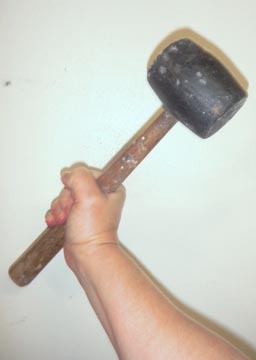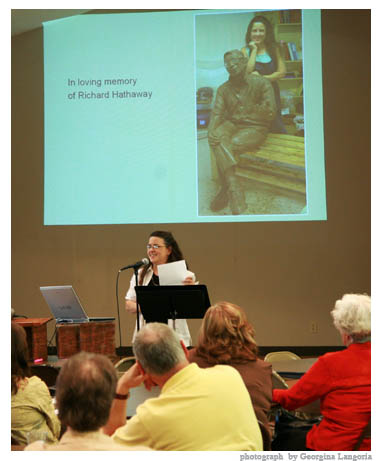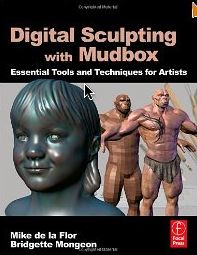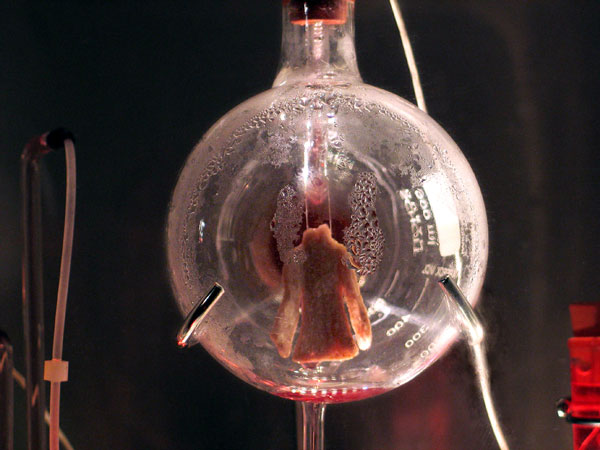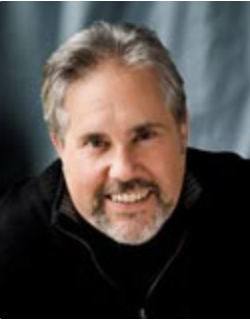3d printing
Is It Easy For You To Identify And Judge 3-Dimensional Shapes, Distances And Proportions On a Computer Screen? An Interview Cont.
9. Is it easy for you to identify and judge 3-dimensional shapes,
distances and proportions on a computer screen?
1. The hardest part, and we mention this in the book is the size of the sculpture. If I am working on a maquette in the studio, I know if I enlarge that maquette 500% I will not have as much detail as I need. So what is the actual size of a virtual piece of art? What happens with the translation from digital work a the size I have created, to the physical size I need output?
2. I would love to see calipers in the digital programs. Something that resembled more traditional calipers in a digital environment.
3. I also was very confused when I first worked in mudbox with perspective view and orthographic view.
4. There is also a cliche with Macs that if you hit the some keys in a certain order your sculpture flips. This is not just a problem with Mudbox or Zbrush but many graphics programs. This freaked me out, and I wish someone could solve this.
5. It is easier for me to judge 3d space now than in the beginning. Though when symmetry begins to act funky, and I know It is some sort of driver error, I get a bit frustrated. I love being able to spin around a sculpture.
6. I do wish that I had more access to my photographs. The one solution I have found for this is Macs Photstickies.
By the way, question number 8 was
8. Which medium is more comofortable for you to use?
( see other posts)
This is an interview of 10 questions by Mathias Herbster of FH Vorarlberg University in Austria directed to Sculptor Bridgette Mongeon about the comparison of digital and traditional sculpture.
______________________________________________________________

Sculptor, Writer and Speaker
Bridgette Mongeon is a sculptor, writer, illustrator and educator as well as a public speaker.
Her blog can be found at https://creativesculpture.com.
She is also the owner and creator of the God’s Word Collectible Sculpture series
Follow the artists on twitter twitter.com/Sculptorwriter twitter.com/creategodsword
Facebook http://www.facebook.com/bridgette.mongeon
Listen to The Creative Christian Podcast or the Inspiration/Generation Podcast Click on Podcast Host Bios for a list of all podcasts.
Listen to the Art and Technology Podcast
What Do You Miss In The Digital Sculpting Technology? An Interview Cont.
7. What do you miss in the digital sculpting technology?
As mentioned before, ease and affordability of output. Ease of quickly sculpting without having to worry about topology. As I have mentioned before, retopologizing is actually the holy grail of this process. However, I have seen this change over the last year, and it is quickly becoming a non issue. I look forward to exploring these in the up and coming months.
At first I might have missed much about traditional and I still will continue in it. However, one of the main factors that pushed me in the direction of this exploration was damage to my hand, I could no longer hold a sculpting tool. Years of pushing and pulling clay, pounding with tools or scraping had taken its toll. I have since had surgery and am happy to say I have my hand back, but the advances and exploration of this digital technology will be a very important element of creating late in life, when my body may rise up again in revolt. It has extended my tool set and capabilities as a sculptor far beyond anything I could have imagined for myself.
This is an interview of 10 questions by Mathias Herbster of FH Vorarlberg University in Austria directed to Sculptor Bridgette Mongeon about the comparison of digital and traditional sculpture.
______________________________________________________________
Bridgette Mongeon is a sculptor, writer, illustrator and educator as well as a public speaker.
Her blog can be found at https://creativesculpture.com.
She is also the owner and creator of the God’s Word Collectible Sculpture series
Follow the artists on twitter twitter.com/Sculptorwritertwitter.com/creategodsword
Facebook http://www.facebook.com/bridgette.mongeon
Listen to The Creative Christian Podcast or the Inspiration/Generation Podcast Click on Podcast Host Bios for a list of all podcasts.
Listen to the Art and Technology Podcast
Which Medium Do You Think Is More Flexible, Digital or Analog Clay? An Austrian Student Interview Cont.
2. Which medium do you think is more flexible, digital or analog clay?
I have described a bit of this in a previous post, however, in defense of digital sculpting, the tools that are available intrigues me. For example, sculpting symmetrically, though no person is symmetrical, I can change that at the end. But in digital I don’t have to sculpt two eyes, or two ears, etc. When I can shorten the amount of time of getting the shape and instead focus on the detail the technical process allows me more time for creativity.
By far the most hindering part of the digital process is the output. There are still a few factors that interfere with my process in this area. One is cost, and the other is the medium, also the build envelope or size. I’m finishing a bust in traditional clay right now, but I would much rather have created it digitally. However, my resources for out put would have been milling in foam, a good armature for larger pieces, but I would have still had to do the details again, and I do not like the stiff look that a piece of foam covered in clay has.

I could mill it out in stone; I must say I anxious to have a project where I can explore this more. All my life I have sculpted in clay, concrete, bronze or pourable mediums. Now with digital milling in stone I can extend my tool set to “stone carver”. With the Digital Stone project, I can create artwork in this medium, as well. This excites me to no end. When I think of the possibilities I also consider the many projects I have given up over the years not having this skill set.
I also love the idea of doing more architectural sculpting work using the digital tools. Creating a finial and being to enlarge it 20% or anything in steps of enlargement is huge. There is no price that can be put on that.
However, digital printing in any other medium is not a viable option, either because of the build envelope or the cost.
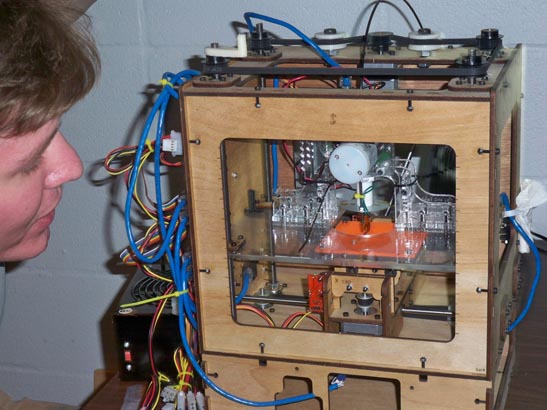
Im intrigued with the research at Solheim Additive Manufacturing Laboratory in the Mechanical Engineering Department on the University of Washington campus. If only I could create in the computer and then digitally print out my form in clay in my own studio, like they are doing at this lab. I think this would be a viable resource for me. I know that the open source “free” 3d printers like Rep Rap or maker bot have some attachments to digitally print in clay, and I’m waiting to see how these evolve.
I think another resources is materialize by .mGX for going directly to bronze, though very expensive. I have visions of using them on an intricate piece similar to Alfred Gilbert’s Virgin Mary or St. Michael. Pieces that would be a nightmare to recreate in a triditional bronze process but could easily be done with .MGX.
The very near future will drastically change the way I work. As many of the patents have ended on 3D printing, I believe you will begin to see a change in the cost factor and availability of home 3D printers. I still may be limited by the build size, unless, of course, I can figure out how to change a machine to accommodate my needs. I’m not sure I am that mechanically savvy.
As I write this, I find an aching. To go from screen to finished project without touching it leaves a hole inside of me. I am afraid I will not be able to “feel” the emotion of the piece unless I touch it. Oh, this is a strange thought.
Though looking at the quick sketches in my Mudbox video I can feel the emotion without touch. Will it feel the same digitally printed?
Remember, I am still a traditional artist. I get paid for a tangible piece of art. I need to get the sculptures out of the computer. I must base my choices on that final output.
This is an interview of 10 questions by Mathias Herbster of FH Vorarlberg University in Austria directed to Sculptor Bridgette Mongeon about the comparison of digital and traditional sculpture.
_____________________________________________________________________________

-Sculptor, Writer and Speaker
Bridgette Mongeon is a sculptor, writer, illustrator and educator as well as a public speaker.
Her blog can be found at https://creativesculpture.com.
She is also the owner and creator of the God’s Word Collectible Sculpture series
Follow the artists on twitter twitter.com/Sculptorwriter twitter.com/creategodsword
Facebook http://www.facebook.com/bridgette.mongeon
Listen to The Creative Christian Podcast or the Inspiration/Generation Podcast Click on Podcast Host Bios for a list of all podcasts.
Listen to the Art and Technology Podcast
What Makes Sculpting In Clay Appealing To You? An Austrian Student Interview Cont.
1. What makes sculpting in clay appealing to you?
I am a tactile person. I love the feel of clay in my hands, the softness of wet clay out of the bag allowing me to quickly rough in the general shape, the leather hard stage providing the perfect texture for carving in intricate details. The smell of earth, the sound of the water as it is sucked into dry clay in a cup— regenerating it into a malleable medium.
Working in this medium for over 25 years there is more. My brain has developed synapsis that are strictly 3 dimensional. I can quickly rough in a figure and gesture, bringing emotion to an object in clay, much faster than I can in a 2d sketch. In fact, I have noticed that my brain misfires, skips, or bluntly—farts when I am trying to bring thoughts from my brain into two dimensions, though I have continued to sketch my entire life, working in clay or a 3D form helps me to express that creativity quicker. My study of emotion in art, especially facial expression and psychology and science behind that, is exhibited in my sculptural forms and my creations of posthumous sculptures. I have trained myself in the precision of finding the emotion and transferring it to the clay. I’m not sure if this transpires in digital form. It probably does, and I do my best to explain it in my lectures, but it is a very abstruse, imperceptible process.
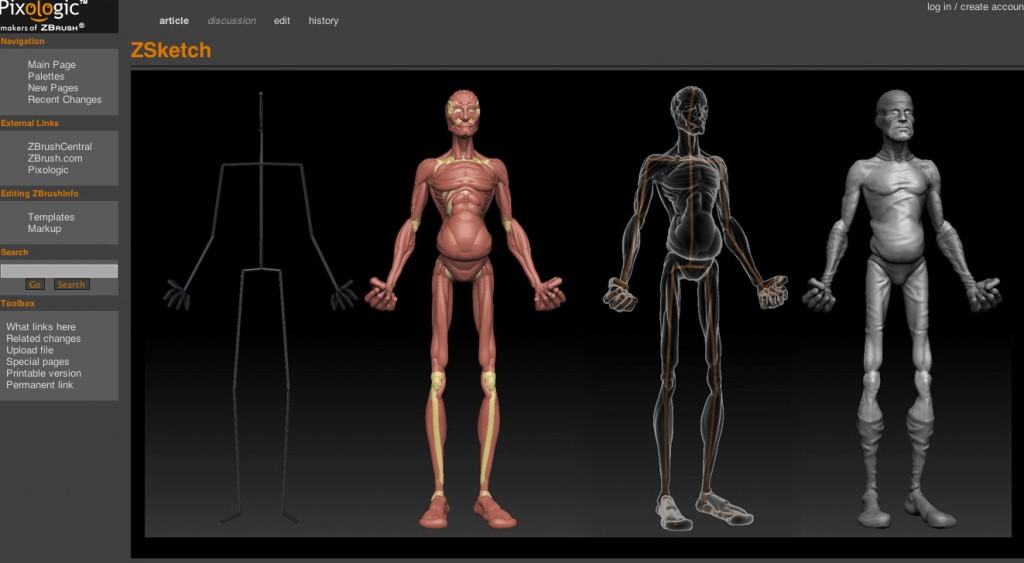
I must say that I do love the immediacy of the medium. I love being able to quickly squeeze and pinch or pull a shape out of a blob. This was probably my most frustrating aspect of digital sculpting, but is quickly changing. I hated having to be bound by the geometry under a piece, it still pisses me off from time to time. Zbrush’s zsketch is more in tuned to my traditional process though I am still butting up against geometry every now and then. I would say the same with being able to pose or move a piece. For me, doing this digitally (Zbrush, Mudbox) is time consuming and leaves me fumbling. I want to play with the form before finalizing it, and I do not feel as comfortable digitally with that as I would like. Some say the geometry is the armature. To me, that is a poor analogy, it is more like grit that is caught in my traditional clay and totally irritating me as I try to dance my hand over it.
This is an interview of 10 questions by Mathias Herbster of FH Vorarlberg University in Austria directed to Sculptor Bridgette Mongeon about the comparison of digital and traditional sculpture.
_____________________________________________________________________________

Sculptor, Writer and Speaker
Bridgette Mongeon is a sculptor, writer, illustrator and educator as well as a public speaker.
Her blog can be found at https://creativesculpture.com.
She is also the owner and creator of the God’s Word Collectible Sculpture series
Follow the artists on twitter twitter.com/Sculptorwriter twitter.com/creategodsword
Facebook http://www.facebook.com/bridgette.mongeon
Listen to The Creative Christian Podcast or the Inspiration/Generation Podcast Click on Podcast Host Bios for a list of all podcasts.
Listen to the Art and Technology Podcast
An Austrian Student Interviews Me On Comparison Of Digital And Traditional Sculpture
I have worked hard over the last few years exploring the digital technology and trying to bridge the gap between digital sculpture and traditional sculpture. I have explored the process in my book Digital Sculpting inMudbox Essential Tools and Techniques for artists, with the Art and Technology podcasts, and in lectures that I have presented to organizations and institutions. Should your institution want me to come and talk about these topics, please feel free to contact me with the details.
My graduate studies and the writing of my first novel distracted me for the past year, but I’m looking forward to getting back to the topics surrounding digital technology. The technology continues to change. I really want to write a book about the technology and the processes. It would be wonderful to focus on the incredbiel artwork stemming from the use of this technology. I see it as a guidebook of resources, as well. There are also many new issues surrounding the use of digital technology that need to be addressed. I’m still looking for a publisher that will get behind the need for this information.
Today, I woke and found an e-mail in my in box from a student from FH Vorarlberg University in Austria. Mathias has the same desire and direction and focus that I have with sculpting/digitally and traditionally and wants to interview me. I’m flattered, but more than that I feel comforted. In my life, it is extremely important to pass on information and help others. I find it in all aspects of my life— a driving force. To see that my podcasts, articles, books and desire have reached half way around the world to someone else with the same passion and direction, is inspiring. I thought it would be interesting to answer these questions publicly on my forum.
_____________________________________________________________________________

Sculptor, Writer and Speaker
Bridgette Mongeon is a sculptor, writer, illustrator and educator as well as a public speaker.
Her blog can be found at https://creativesculpture.com.
She is also the owner and creator of the God’s Word Collectible Sculpture series
Follow the artists on twitter twitter.com/Sculptorwriter twitter.com/creategodsword
Facebook http://www.facebook.com/bridgette.mongeon
Listen to The Creative Christian Podcast or the Inspiration/Generation Podcast Click on Podcast Host Bios for a list of all podcasts.
Listen to the Art and Technology Podcast
Creating An Author’s Page At Amazon For The Mudbox Book
For those of you who don’t know, I coauthored a book with my husband called Digital Sculpting in Mudbox: Essential Tools and Techniques. Most software books can become dated, but this book talks about things that others do not. Let me tell you about the two chapters that I am proud of. I should be proud, I wrote them and labored over them. One chapter brings a person through the entire process of sculpting a portrait digitally. Yes, I have taken my traditional process and expressed it digitally. So this book will help with that. You can use it if you are using Mudbox or the competition Zbrush. It will also help if you are a traditional sculptor. The other chapter talks about digital printing, milling and scanning. This is huge and I would love to do an entire book on this subject, just in case there should be a publisher that is interested. For those of you who don’t know, you can now print things in 3d. Yes, you can create objects in the computer and print them. Kind of like the Star trek replicator. The difficulty is, that not many artist know the processes that are available for this sort of thing. That is what this chapter is about. Breaking it down into bite sized pieces and also offering the reader a list of resources. In my opinion, this information is worth purchasing the book. You just can’t find it compiled anywhere else.
If you want to see my authors page just click on this Amazon link to the book and then on my name.
We have also put together a website and forums for this book. It is located at digitalsculpting.net Be sure to also check out the podcasts on art and technology at the website.
Very Excited About New Marketing Brochure
We have been working diligently on a couple of different marketing plans and target markets. The first is a brochure that is going out to architects, landscape Architects, Interior Designers, and Landscape Designers.
I’m thrilled because it introduced our new digital sculpting services.
This is a tri fold brochure.It has been created by the new intern, Tiffany Post Actually she is not my intern she belongs to my husband’s company, MD Communications next door, but she has been on loan to me for the last couple of weeks. Tiffany is graduating from The Art Institute of Houston. She hopes to get a job in design. I am sure she would be open to freelance work if anyone needs anything, and at a good price. Great way for her to build a portfolio.

It can be a self mailer,
but who could put a label over that lion.
I really like the way the back came out.
Good thing the cards come with envelopes.
The printer we are using on this job was recommended by designer and photographer Christian Sizemore. She also does freelance work. WHCC has reasonable prices and does some nice work.
I would love to hear what others think about the brochure. Will be sent to printer next week.
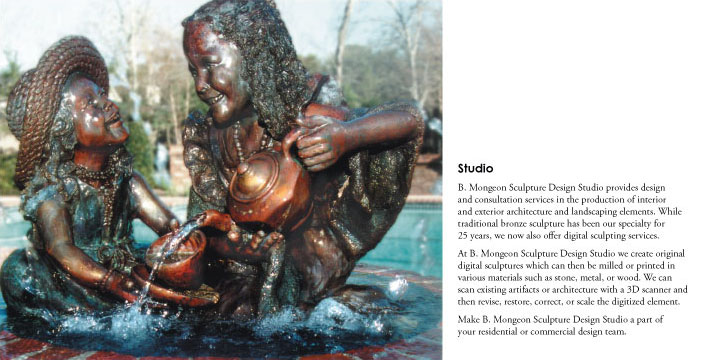

______________________________________________________________________________

Sculptor, Writer and Speaker
Bridgette Mongeon is a sculptor, writer and educator as well as a public speaker.
Her blog can be found at https://creativesculpture.com.
She is also the owner and creator of the God’s Word Collectible Sculpture series
Follow the artists on twitter twitter.com/Sculptorwriter twitter.com/creategodsword
Facebook http://www.facebook.com/bridgette.mongeon
Listen to The Creative Christian Podcast or the Inspiration/Generation Podcast Click on Podcast Host Bios for a list of all podcasts.
Listen to the Art and Technology Podcast
A New Book Proposal
I just sent a new book proposal to the publisher. Art and Technology- Exploration of resources and advancements in digital sculpting, printing, milling and scanning. I know, I am just able to breath after fishing Digital Sculpting with Mudbox Essential Tools and Techniques for Artists.
I’m also knee deep in the Art and Technology podcast and the new website at http://www.digitalsculpting.net
The new book project is terribly exciting. It will feature a great deal of the research I am doing on this subject for my graduate studies. As I stated in the book proposal.
Art and Technology- Exploration of resources and advancements in digital sculpting, printing, milling and scanning. Finally, a resource guide for understanding and accessing tools in digital printing, milling and scanning. This technology is not just for manufacturing or engineering but can be embraced by designers, traditional and graphic artists who want to utilize these technologies in their creativity and in their workflow. This resource breaks down the process and possibilities for artists.
This book helps to inspire, as artists can see what others have created and push their imagination utilizing new technology. The technology can help save artists time and help artists create in ways that have never been conceivable until this time. Inspiration- strengthens your creativity and enlarges your artistic tool set.
I should know something in two – three weeks.
Frankensteinian Art?
My studies of researching digital technology and incorporating it into my traditional sculpting processes is part of what I am doing for my graduate degree at Goddard. It has taken me to places I would have never dreamed of going. Several months ago while researching 3d printers I began to realize that individuals were pushing anything they could through the printers to see what would happen, metal, ceramic, even glass. It was then that I wondered about biology. And I was certainly thrown for a loop when I found that they were printing bone, skin and now even organs. I wrote about this and had several links to articles about the subject in the October 28th blog article, I’m a genius! 3D Printing of the Human Organs?
I did, at that time, however, happen upon another artist’s work that after finding and reading I quickly clicked off of. The project has haunted me since then. There was such uneasiness when I first happened upon it that I didn’t even put it in my college bibliography. I am wondering now, why. Why am I so uneasy? It was exciting for me to find that science is now printing biology, and that someday, if I need a kidney I might be able to have my own kidney printed. But incorporating this other type of biology into art left me feeling uncomfortable. The topic has come up more than once since this first encounter with Stelarc’s art piece The Partial Head. The Partial Head is a prosthetic portrait of the artist that is computer generated and can talk to the viewer. This portrait is digitally printed and then seeded with living cells. Of course, the artwork needed a bioreactor/incubator circulatory system to survive. It only lived a week before becoming contaminated and “died.”
The Partial Head website acknowledges the collaboration of, The Tissue Culture & Arts Project (TC&A). http://www.tca.uwa.edu.au/ In a Leonardo Journal, article entitled, Growing Semi-Living Sculpture: The Tissue Culture & Art Project by Oron Catts and Ionat Zurr it state that they use “living tissue to create/grow semi-living object/sculptures and to research the technologies involved in such a task.” I need to examine, in my own mind, why creating organs to extend life, and using living cells to create art feels so different to me. Though both remind me of the scene from the movie Frankenstein.
Victor Moritz: Henry – In the name of God!
Henry Frankenstein: Oh, in the name of God! Now I know what it feels like to be God!
Is it my cultural upbringing that makes me uneasy about this? I have warned myself to be careful. Some fear is healthy; it does keep us from danger, however, it can also keep us from exploration. The difficulty is in knowing when have we gone too far.
Doctor Waldman: You have created a monster, and it will destroy you!
Another Sterlarc’s project consists of growing a 1 /2 scale ear. In another piece of art titled. Victimless Leather The TC&A project works at initiating a discomfort in the viewer as they digitally print a miniature coat over scaffolding with tissue that looks like — human skin.
Of course, growing things can be found everywhere. How is this technology any different than growing a topiary over a metal structure that becomes a living thing that will grow and I must tend? There are many ethical questions raised with TC&A ‘s project. For example, “Do these entities contribute to the objectification of living organisms?” In my previous comparison I honestly don’t feel that I am objectifying the ivy on the topiary. Nor do I feel I am killing portions of it when I prune the art. How is this different? Are we enthused with our control over the living material? This Frankensteinian idea towards art was also expressed in a recent Art and Technology podcast that I conducted with Robert Michael Smith. It appears these questions will continue to be raised and that artists that are presented with tools to push their creative limits and to initiate a reaction in the viewer will do so. It has certainly initiated a reaction from me. It will continue, and we just may see more art that for lack of a better word, can be referred to as Frankensteinian.
TC&A also examines, “the gap between the fast pace of development in science and technology and the slower pace of cultural understanding and adaptation.” They are indeed pushing the limits of acceptance both socially and culturally. They hope that the term “semi living object/products and sculptures” will make the art more palatable. “Our art challenges many people to examine their perception of the boundary between the living and the inanimate:” Their goal is get these projects to a point where the art can live out of their contained environment and provide tactile interaction with the viewer. I’m sure this will not be the last you hear about this subject on this blog, or the Art and Technology podcast. But I’m interested in knowing what other people feel about these works of… “art?”
Look! It’s moving. It’s alive. It’s alive… It’s alive, it’s moving, it’s alive, it’s alive, it’s alive, it’s alive, IT’S ALIVE!
Henry Frankenstein
( Oron Catts will be one of my up and coming interviews ( INTERVIEW) on the Art and Technology Podcast listen from the Digital Sculpting.net website or Subscribe to the podcast in itunes ) This podcast was recorded May 23, 2010 and will be up at the http://www.digitalsculpting.net website by May29th.
If you are reading this blog post from facebook and do not see the videos and or photographs visit https://creativesculpture.com/blog
The New Podcast Art and Technology is Up- Feel Free To Use Them On Your Site
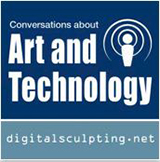
“A fire side chat where innovation, creativity, technology and science meet.”
Art and Technology Podcast
The art and technology podcasts are up. And you are welcome to include them on your site. Check out the link at the end of each post here. You can listen to the podcast at http://www.digitalsculpting.net. Once there, press on the link in the upper nav bar that says “podcasts.”
The podcast has been submitted to iTunes and we will let you know when you can subscribe to it in iTunes. We would, however like to have you stop by digital sculpting.net to listen and reply on the forum threads for each post. It is a great way to create a dialogue on these topics.
I’ll also put a direct link to the new podcasts below so you can listen right from your browser.
You can see a player and listen from this website at Videos and Podcast page of this website.
Here are the podcasts that have been recorded to date:
____________________________________________________________________

and Technology
Podcasts and
author of Digital
Technology in Fine
Art and Craft:
Exploring 3D Printing,
Scanning, Sculpting,
And Milling.
Art and Technology 001- Introduction
LISTEN NOW from your browser
An introduction to the Art and Technology Podcast. Host Bridgette Mongeon and illustrator/writer Mike de la Flor talk about their hopes for digital sculpting.net, the Art and Technology podcast and the new book Digital Sculpting with Mudbox: Essential Tools and Techniques for Artist.
A bit about the host Bridgette Mongeon
Bridgette is a traditional sculptor and a writer. She has been creating podcasts for two years on various topics and looks forward to exploring art and technology with the community at DigitalSculpting.net. Her passion for this subject is fueled by her ongoing graduate studies. She is also coauthor of the new Mudbox book and co-administrator for the digitalsculpting.net website
Interview with Mike de la Flor
Mike is a medical, illustrator/animator, instructor and writer. He is the author of several CG titles including the popular The Digital Biomedical Illustration Handbook. He has written dozens of articles for 3DWorld, Computer Arts, and MacWorld among other magazines. Mike is also the co-administrator of the DigitalSculpting.net website.
* Listen to the podcast from our podcast player on the nav bar at Digital Sculpting.net
* The forum for this topic. You may add your comments and thoughts
* The direct link to this podcast segment- should you want to put it on your website or blog
http://media.libsyn.com/media/artandtechnology/Art_technology_001.mp3
____________________________________________________________________

An Interview with sculptor Robert Michael Smith. Art and Technology 0002
Please see previous post for more information about Robert Michael Smith
LISTEN NOW from your browser
* Listen to the podcast from our podcast player on the nav bar at Digital Sculpting.net
* The forum for this topic. You may add your comments and thoughts
* The direct link to this podcast segment- should you want to put it on your website or blog
http://media.libsyn.com/media/artandtechnology/Art_technology_002.mp3
____________________________________________________________________
An Interview with Joris Debo from Materialise .MGX Art and Technology 0003
LISTEN NOW from your browser
An Interview with Joris Debo from Materialise .MGX discussing some of the highest quality of 3d Printing.
Joris Debo from .MGX, a division of Materialise talks about the technology of large scale 3d printing and investment casting that their company is offering to the traditional and digital studio. .MGX works with 3D printing technologies and some of the top designers in the world.
Check out the .MGX catalog for some very inspiring artwork
This link lets you download both catalogs
* Listen to the podcast from our podcast player on the nav bar at Digital Sculpting.net
* The forum for this topic. You may add your comments and thoughts
* The direct link to this podcast segment- should you want to put it on your website or blog
http://media.libsyn.com/media/artandtechnology/Art_technology_003-_Interview_with_Joris_Debo.mp3
____________________________________________________________________
Interview with Kevin Gillespie Art and Technology 0004
LISTEN NOW from your browser
Kevin Gillespie pioneer in CG, talks with Host Bridgette Mongeon about 3d technology and copyrights- from a personal viewpoint. How can we protect ourselves as artists? How can we be more aware? Copyright in 3D is an emotionally charged issue.
For more information on this case, copyright issues and other information as well as a discussion of this topic please visit the digitalsculpting.net website. We would love to hear what you think about this heated topic.
* Listen to the podcast from our podcast player on the nav bar at Digital Sculpting.net
* The forum for this topic. You may add your comments and thoughts
* The direct link to this podcast segment- should you want to put it on your website or blog
http://media.libsyn.com/media/artandtechnology/Art_technology_004_Interview_with_Kevin_Gillespie_on_Copyright_and_3D.mp3
MORE INFORMATION ON THIS TOPIC
Article Not a Model Decision a wonderful blog article by a lawyer
Article Important Case ( maybe): 10th Circuit on Copyrightability of Digital Model
____________________________________________________________________
So who is next?
Some great guests are planned:
Andrew Silke– From the Guerilla CG project
Adrian Bowyer– the developer of the REP RAP
Next Engine– digital scanning
Oron Catts– The Tissue Culture & Arts Project ( this is a strange one, you must listen)
____________________________________________________________________

